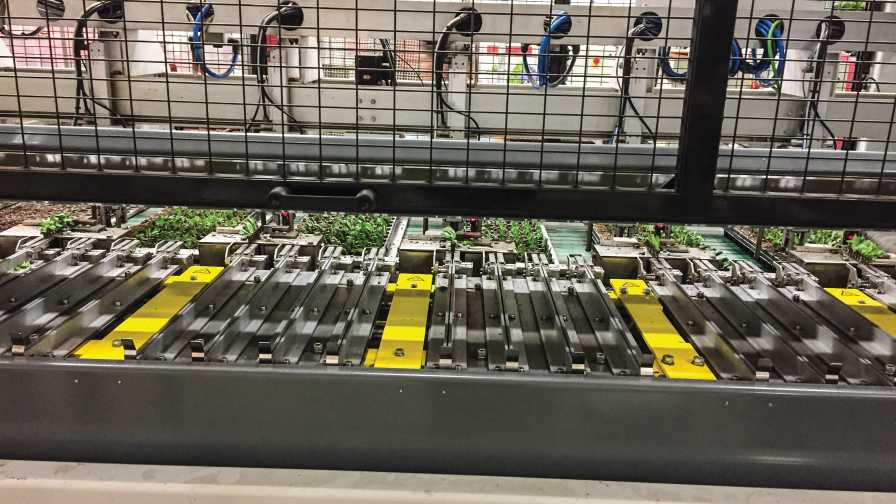Growers Break Down Benefits, Return on Investment for Cuttings Transplanters

At Dickman Farms, the AutoStix transplanter does 9,500 cuttings per hour with a 99% stick rate.
While the lion’s share of the action takes place on the trade show floor, the educational sessions organized and offered at Cultivate’19 often prove of significant value for many attendees. This year, one interesting entry to the speaking program was the Transplanting Cuttings by Hand and Robotics panel, which featured four ornamental growers of varying size that have adopted robotic transplanters. The panel was moderated by University of Florida’s (UF) Professor and Floriculture Extension Specialist Paul Fisher.
Fisher kicked things off by presenting findings from a UF research project that polled young plant growers (all with annual revenues starting at $1 million) across the U.S. on their views and experiences with robotic transplanter machines.
The growers polled by UF nearly unanimously agreed that reduced labor availability was the top reason for adopting automated transplanters in the greenhouse. The study also found the average producer surveyed ended up shelling out about 0.014 of a cent per cutting for manual sticking, while robotic transplanters, on average, cost about 0.010 of a cent per cutting.
“Everyone knows that labor is the number one issue for our industry, and labor availability is a main driver for adopting automation,” Fisher said. “We’ve found that your return on investment (ROI) when it comes to robotics is going to depend on the individual details of your growing operation.”
The Panel Lays Out Its Case
The panel featured Mike Goyette of Pleasant View Gardens, Bob Dickman of Dickman Farms, Jeff Back of Four Star Greenhouses, Gail Berner of Spring Meadow Nursery, and moderator Paul Fisher of the University of Florida. The members discussed their experiences with automated sticking robots next, with Greenhouse Production Manager Gail Berner discussing her company’s use of the technology in its mostly woody cuttings business.
Berner said Spring Meadow currently does about 60% of its cuttings production via manual sticking, but the nursery has witnessed about a 17% increase in production and a 63% increase in efficiency when using the robotic stickers.
Operations Manager Mike Goyette was up next. Goyette said Pleasant View Gardens, which sticks about 35 million cuttings per year, is still at around 90% manual sticking versus 10% done via two ISO Cutting Planter 2500 transplanters.
The company typically hires about 60 workers to stick cuttings by hand during peak season, though 2019 proved extra challenging in that regard, as wages among Pleasant View’s workforce were up 20% from the previous season.
“We found that having more than one robot working at the same time can increase that ROI timeframe,” Goyette said.
The Labor-Saving Benefits of Transplanters Are Hard to Beat
General Manager Bob Dickman would likely agree with Goyette. Dickman Farms is facing mounting pressure on its bottom line via New York’s recent farm worker labor reform bill that increases the minimum wage paid to farm workers in the Empire State by 29% over the next four years, reaching $15 an hour by 2022.
“We’re always going to need labor (as an industry), and we’re always going to need people to transition from manual sticking to other aspects of the greenhouse,” he said.
Enter Visser Group’s AutoStix bots, which Dickman Farms now uses for about 80% of its cuttings, replacing nine full-time workers per machine. Manual stickers in the past have stuck about 700 cuttings per hour at Dickman, while the AutoStix can run through 9,500 per hour with three employees interfacing with the machine as operators.
“It’s basically set-it-and-forget-it [with AutoStix], because I know no matter what, it is going to be able to get through those 9,500 cuttings per hour,” Dickman said. “And you can train an operator on it in two days, not to mention you get a 99% stick rate with very little patching.”
Jeff Back, Director of Greenhouse Operations at Four Star Greenhouse (Carleton, MI), says Four Star is currently running three ISO Group transplanters along with a single AutoStix machine acquired back in 2018.
He said the main benefit Four Star has witnessed from automating most of its transplanting process is in the length of time the machine can operate without a break. Considering Four Star runs through, on average, 3.5 million cuttings in a peak week, it’s easy to understand why scaling up with robots and automation appeals to a massive operation like Four Star.
With three ISO Cutting Planter 2500s sticking around 2,400 cuttings per hour, and the high volume AutoStix machine topping out at nearly 9,600 cuttings per hour, robotic transplanting technologies are at Four Star to stay.
“Our workers and management are getting used to robotics being the way of life for us and the rest of the industry, and we’ll continue to invest in these technologies as long as the payoff is there,” he says.








